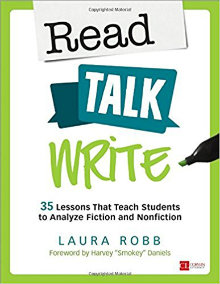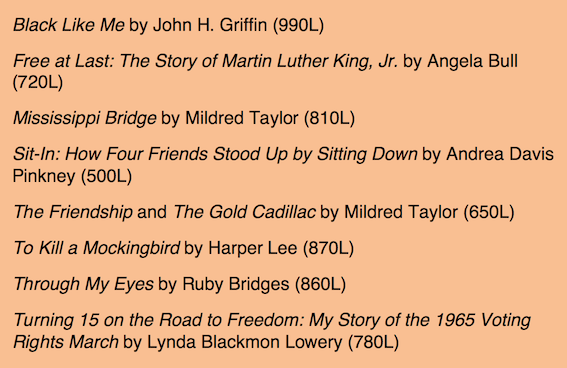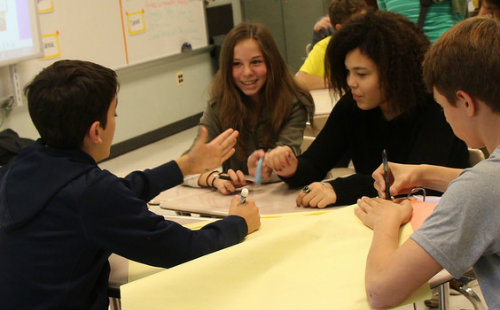Use Leveled Books in Student Led Discussions
Passionate educator and popular author Laura Robb shares her ideas for moving teaching into the age of choice and collaboration!
By Laura Robb
It’s time to let go of 19th-century instructional methods that are alive and well in too many middle school classrooms around our country. Take a deep breath and think of the students sitting in classrooms you know about and consider how well the following practices serve them.
Practice: The entire class reads the same book.
Pitfalls: One book serves the group who can read it. Students who can’t read the book aren’t reading, and those who find it easy aren’t progressing because the book is at their independent reading level.
Practice: The teacher leads a recitation and asks questions that usually have one correct answer, then selects students to respond. Immediately, the teacher moves on to the next question.
Pitfalls: Asking students to answer literal questions doesn’t foster critical and analytical thinking. Moreover, students don’t have opportunities to pose and discuss their own questions.
Practice: Students complete worksheets with multiple choice and fill-in-the-blank questions.
Pitfalls: Fill-in-the-blanks and multiple choice questions are artificial checks to gauge literal comprehension; they are not authentic responses to reading. Research shows that when students write authentic responses about books they read, their comprehension rises by 24 percent.
Practice: Students sit in rows.
Pitfalls: A hallmark of 21st-century learning is collaboration. Sitting in rows isolates students and discourages generating ideas and discussing worthwhile texts in small groups.
Updating Teaching Practices
You can avoid the pitfalls associated with these traditional methods by implementing robust practices that differentiate instruction so that all students can improve their reading, writing, critical thinking, and collaboration skills.
It’s beneficial to work with a colleague so you can support one another and observe the changes in action when you visit each other’s classrooms. By differentiating reading instruction and inviting students to discuss diverse texts using student-led conversations, you can heighten their ability to analyze texts and hone their critical thinking skill. Let’s break it down.
Differentiating Reading
We need to shift our practice from students reading the same book to students reading books at their instructional reading level. This practice is quite manageable when you offer books at different reading levels that are connected by genre, theme, or topic, enabling students to talk and think together even though they are reading different books. Rather than “covering” a specific book, reading instruction becomes focused on the ideas you want students to understand.
For example, Ms. Galloway’s eighth grade class was reading Harper Lee’s To Kill a Mockingbird. Out of 27 students, 10 could read and comprehend the book. However, when I asked her what she wanted students to learn from that book, she said, “I want them to understand what it was like for African Americans before civil rights.”
Armed with her idea, Ms. Galloway and I found several books that met the instructional reading levels of her students and addressed her target concepts. Differentiation enabled every student to reflect on life in the South prior to civil rights legislation using a text he or she could read — and every student could contribute to a meaningful, collaborative discussion on the topic. Here’s our list with lexile levels:
And here are some tips for developing units with diverse texts that reach every reader in your class.
Tip 1: Identify the idea(s) you want students to explore as they read.
Tip 2: Ask your school and community librarians to find books related to these ideas on the reading levels of students in your class.
Tip 3: Organize stacks of books on the same reading level. Invite students to browse through the books at their instructional reading level and choose one to read.
Tip 4: Chunk books by having students read three to four chapters, then stop to hold a partner or small group student-led discussion on that section.
Student-Led Literary Conversations
A powerful form of thinking and communicating, student-led conversations can last from five to 15 minutes and bring social interactions to students’ learning. When students are in charge of discussing books they selected and can read, motivation and engagement soar. These conversations develop critical thinking and strong communication skills as students practice framing responses to peers that represent their ideas with clarity.
Have students take turns volunteering to be the group’s leader. The primary job of the leader is to maintain the forward motion of the discussion by using prompts such as:
- Can you provide text evidence?
- Does anyone have a different idea?
- Can you elaborate further on that point?
- How does that relate to what (another student) said?
- Can you link that idea to a teacher’s read-aloud?
Open-Ended Ways to Discuss Diverse Books
Students can use literary elements, themes, ideas, and genre structure to discuss different books.
Explore Literary Elements. Have students identify the protagonist and several problems he or she faces; antagonists and how each works against the protagonist; conflicts, themes, and how other characters affect the protagonist.
Focus on Genre. Ask students to discuss genre structure. For example, for realistic fiction they can discuss what makes the characters and plot realistic. For science fiction they can reflect on the warnings about present-day society and/or technology that the author presents.
Think Through Themes. Have students provide examples of unit themes such as obstacles the person or character faces and whether he or she overcomes these. Or ask students to define stereotyping and offer theme statements that are examples of this from their books.
Assessing Discussions
You can observe one to two discussions during a 45-minute class period. Students can also write several key points from a discussion in their readers’ notebooks and/or evaluate the discussions by writing about specific examples raised during the discussion. Encourage self-reflection using these questions: Did I participate? Did I cite evidence? Did I listen carefully? What did I learn about my book? About a different book? About literary elements? About genre? About theme?
It’s helpful to have students compose open-ended, interpretive questions that apply to any text. Interpretive questions have two or more answers. Verb such as why, how, explain, compare, contrast, evaluate can signal an open-ended query. Have students test each question by finding two responses the text supports. Once they’ve identified two different responses, they can compose another question.
By posting questions on a whiteboard, students can choose those that work for their texts or link to a specific area such as theme or genre structure.
You can also ask students to develop queries that lead to self-evaluation and add to them or adjust them throughout the year.
Closing Thoughts
When you incorporate student-led literary conversations, you inspire students to read, talk, and write about texts they choose. Remember, a student-centered approach builds a community of learners who collaborate and support one another. The result? Students improve as readers, writers, communicators, and critical thinkers.
____________



































